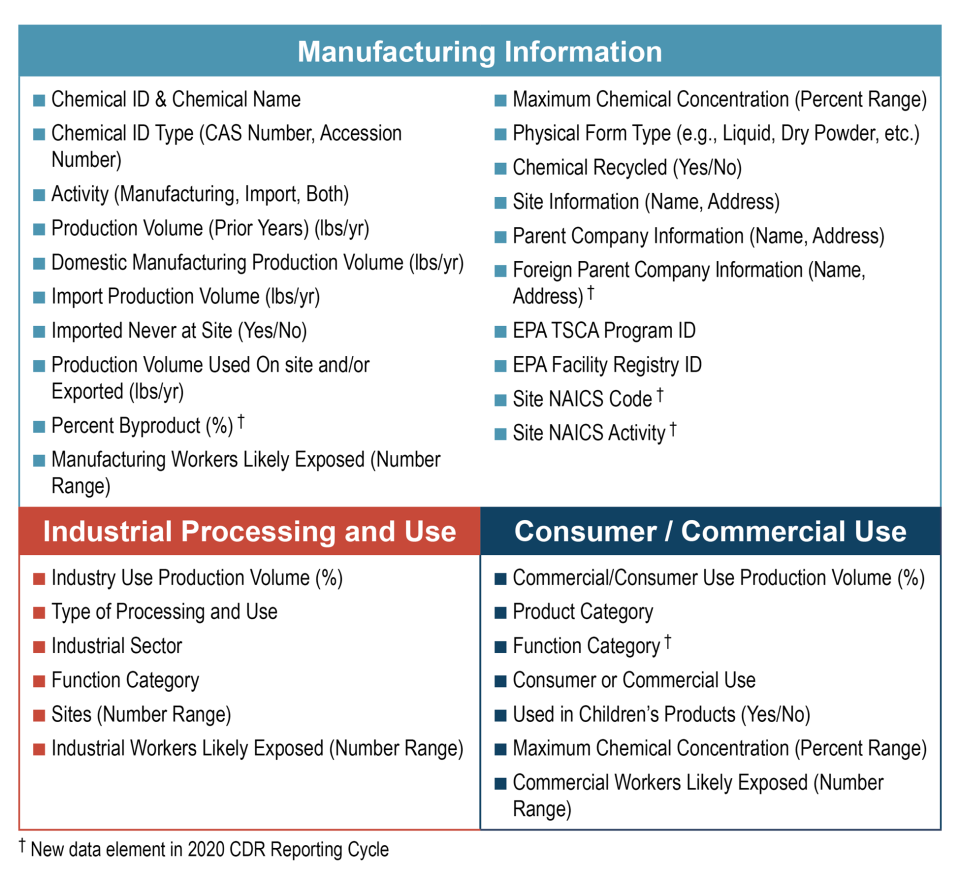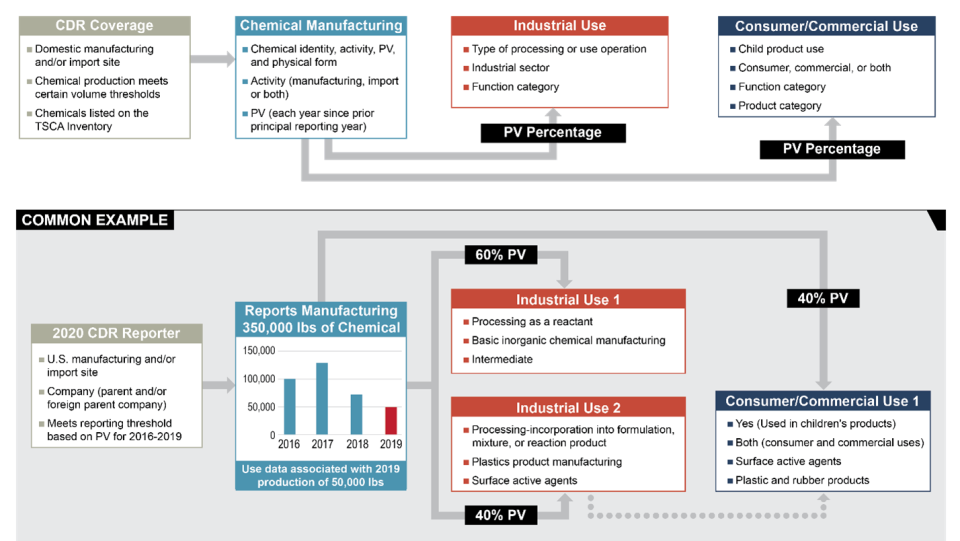2020 CDR National Review
This Review summarizes CDR data in the following sections:
- Overview
- Trends
- Chemical Production Data
- Industrial Processing and Use Data
- Commercial and/or Consumer Use Data
- CDR and TRI Comparison
- Data Limitations
If certain circumstances are met, the Chemical Data Reporting (CDR) rule, under section 8(a) of the Toxic Substances Control Act (TSCA), requires manufacturers (including importers) to report basic chemical exposure-related information, including identities, physical forms, production quantities, and uses of chemicals listed on the TSCA Chemical Substance Inventory and produced domestically and/or imported into the United States. Manufacturers are only required to report on chemicals listed on the TSCA Inventory or, more specifically, existing chemicals. These are chemicals that can legally be manufactured, imported, processed and/or used in commerce in the United States.
For imported chemicals, there are some instances where the imported chemical is never physically at the reporting site. For instance, upon importing a chemical, the site arranges to have the chemical delivered directly to a different location (e.g., a warehouse or a customer site). In addition, an importer may ask their supplier to provide directly to EPA the confidential chemical identity of an imported product.
CDR data are fundamental to EPA chemical management activities. EPA uses the compiled CDR data, along with information from other EPA sources, such as the Toxics Release Inventory (TRI), EPA's National Biennial Resource Conservation and Recovery Act (RCRA) Hazardous Waste Report, and the National Emission Inventory (NEI) to assess risks that existing chemicals may pose to human health and the environment.
Note that submitters can claim certain CDR data as confidential business information (CBI) if publication would reveal trade secrets or confidential commercial or financial information. In preparing the publicly available CDR data, as well as the CDR National Review report, EPA protects confidentially claims while also publishing as much information and analyses as possible. CBI data are protected in the form of aggregate, summary, or range values. To access the data, go to EPA's Access CDR Data webpage.
The 2020 CDR National Review summarizes data for the most recent reporting cycle (2020). The Review includes an analysis of the data reported on the uses of existing chemicals and the quantities of these chemicals produced domestically or imported into the United States. The Review also provides an interactive trend analysis of the data reported for the 2012, 2016 and 2020 CDR reporting cycles. The 2020 CDR National Review is part of EPA's commitment to transparency and enhances understanding and use of CDR data by the public, researchers, state organizations, non-governmental organizations and others.
What Time Period is Covered by Reporting?
CDR reporting cycles occur on a four-year frequency. Sites that domestically manufacture and/or import certain chemicals on the TSCA Inventory submit CDR reports to the EPA if the reporting threshold is met during any of the four years in the reporting cycle.
For example, the 2020 reporting cycle required reporting from sites that met or surpassed the annual production volume threshold—25,000 pounds for any reportable chemical or 2,500 pounds for certain chemicals—during the calendar years: 2016, 2017, 2018 or 2019. Typically, reporting is triggered if a site manufactures (including imports) 25,000 pounds or more of an existing chemical in the principal year (e.g., 2019 for the 2020 CDR Reporting Cycle) or prior years (e.g., 2016, 2017, 2018 for the 2020 CDR Reporting Cycle). For the 2012 CDR reporting cycle, reporting was triggered based on the 2011 production volumes alone (principal reporting year for that cycle), even though reporting sites also provided their 2010 production volumes.
What Data are Reported?
When CDR reporting requirements are met, sites submit information about their chemical activities associated with the principal reporting year (indicated in red in the figure below). For instance, 2019 is the principal reporting year for the 2020 CDR reporting cycle. The site reports information for three different categories: manufacturing (including import), industrial processing and use, and consumer/commercial use. For prior years within the reporting cycle (shown in grey below), sites report total annual production volumes but do not distinguish between domestic manufacturing and import volume. CDR data elements may change between reporting cycles to enhance CDR data applications, integration with other data sets, and data accuracy. The figure below indicates which data elements are new for the 2020 CDR reporting cycle. More information about who must report is available on CDR's basic information webpage.
Data Elements Required for the 2012, 2016, and 2020 Reporting Cycles: Principal Years 2011, 2015, and 2019

» View larger image

» View larger image
For a comprehensive list of changes to CDR reporting requirements (from 2006 reporting cycle to present), see Summary of CDR Reporting Requirements by Year.
CDR data reported to EPA by manufacturers include chemical identity, manufacturing information, industrial processing and use information, and consumer and commercial use information, as shown in the diagram below. An example in the diagram illustrates the type of information that might be reported in each category. For instance, a site that reported for the 2020 reporting cycle provides production volume (PV) information for each year in the reporting cycle (i.e., 2016 through 2019), totaling 350,000 lb. The reporter provides additional manufacturing data and processing and use data—whether for industrial uses and/or consumer/commercial uses—for the principal reporting year (2019), to the extent it is known or reasonably ascertainable.
Within the diagram, of the 50,000 pounds reported as manufactured in 2019, the reporter indicates that industrial sites use 60% (30,000 pounds) of the chemical as an intermediate and 40% (20,000 pounds) as a surface active agent in a plastic product formulation. The reporter also indicates that 40% (20,000 pounds) of the chemical is incorporated into plastic products used by consumers or commercial users.
Note that the same percent PV (40%) and similar use information (plastic products and surface active agent) are reported for "Industrial Use 2" and "Consumer/Commercial Use 1;" this suggests these two uses are related (see dotted arrow in figure). While the industrial use and consumer/commercial use information is reported separately, EPA can analyze these use scenarios in detail (i.e., by site or by chemical) to identify connections to support various agency efforts.
CDR Reporting Overview and Example

» View larger image
